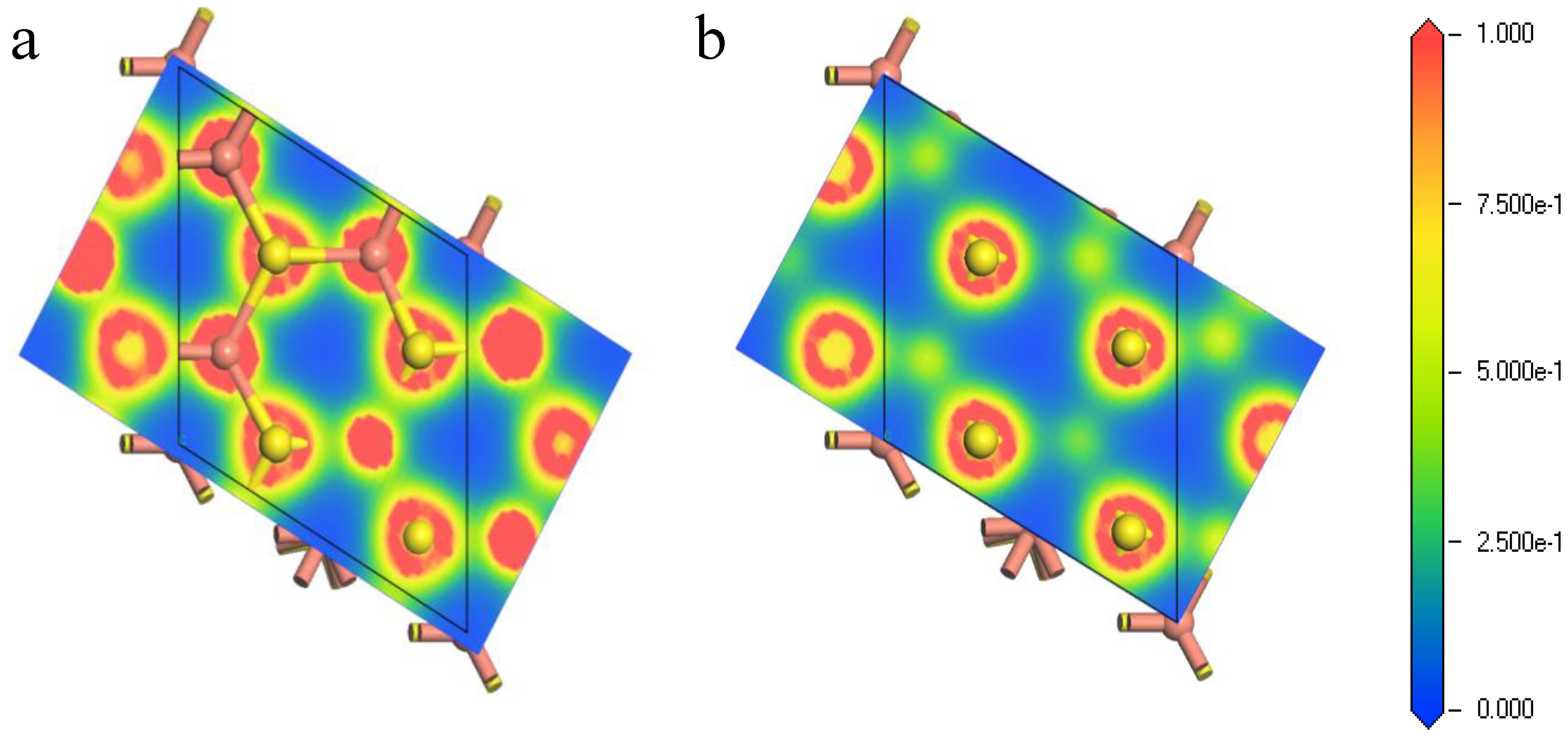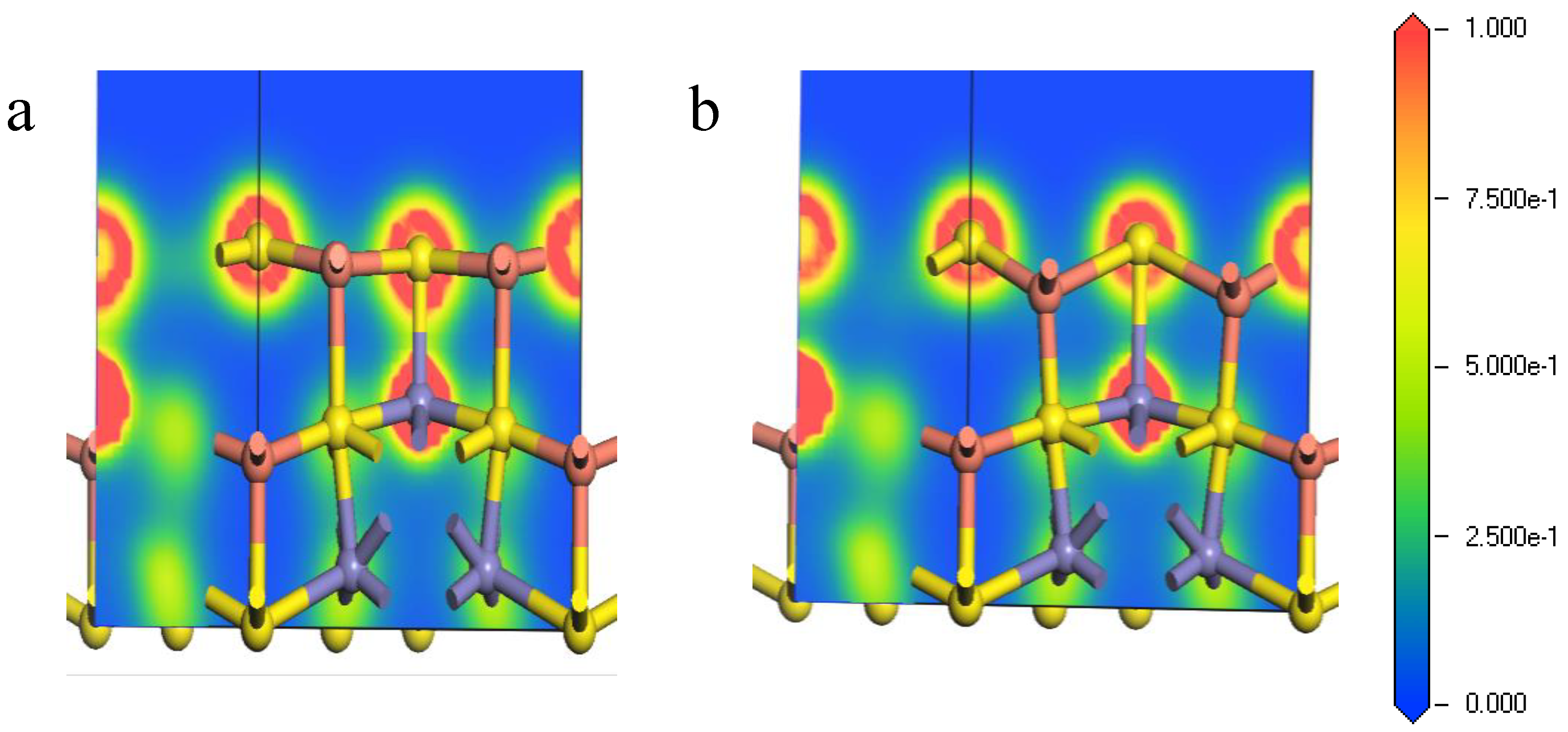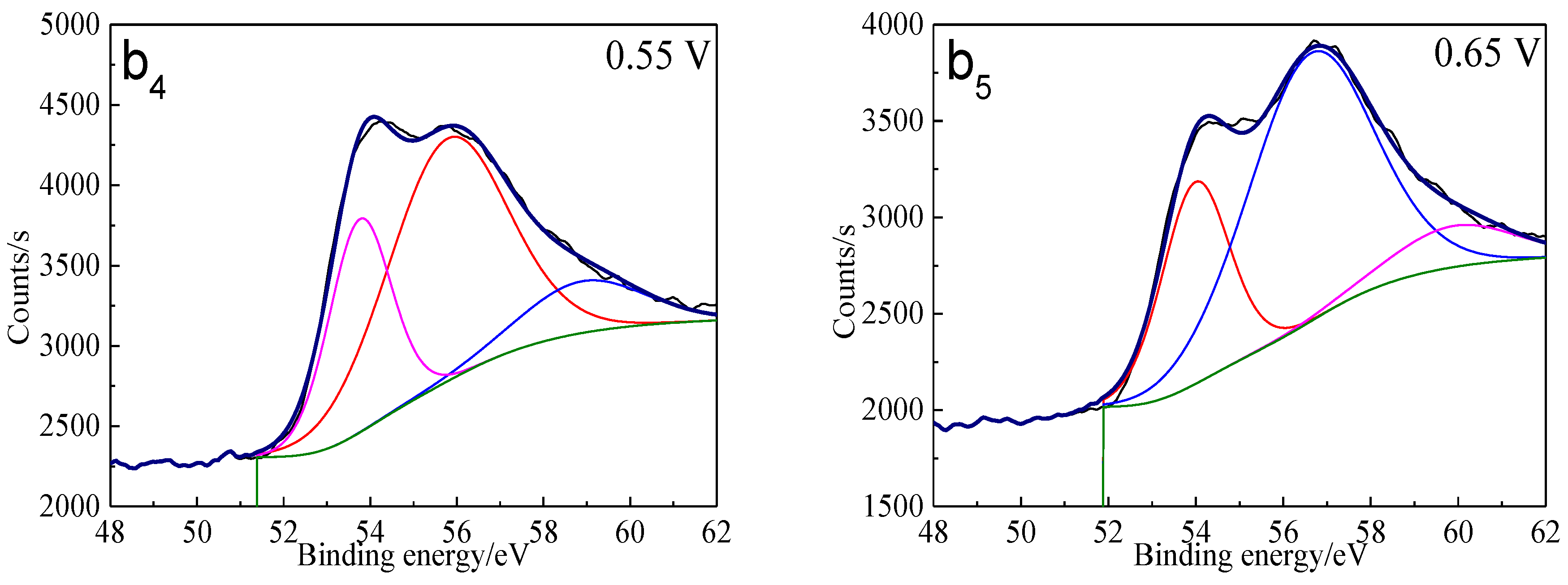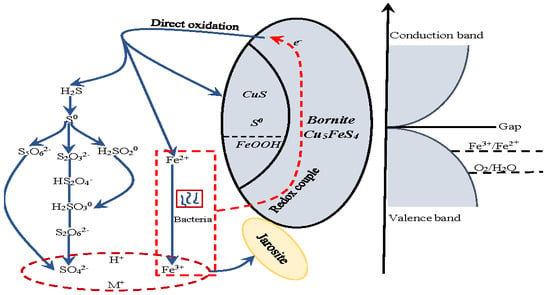Insights into the Surface Transformation and Electrochemical Dissolution Process of Bornite in Bioleaching
Abstract
:1. Introduction
2. Materials and Methods
2.1. DFT Calculation
2.2. Bioleaching Experiments
2.3. Analytic Techniques
3. Results and Discussions
3.1. DFT Calculations of the Bornite Surface
3.2. Surface Transformation of Bornite at Different Potentials
3.3. Intermediate Species of Bornite Surface during Bioleaching
3.4. The Proposed Model for Interpreting the Dissolution Process of Bornite during Bioleaching
4. Conclusions
Acknowledgments
Author Contributions
Conflicts of Interest
References
- Brierley, C.L. Biohydrometallurgical prospects. Hydrometallurgy 2010, 104, 324–328. [Google Scholar] [CrossRef]
- Liu, H.; Xia, J.; Nie, Z.; Ma, C.; Zheng, L.; Hong, C.; Zhao, Y.; Wen, W. Bioleaching of chalcopyrite by acidianus manzaensis under different constant pH. Miner. Eng. 2016, 98, 80–89. [Google Scholar] [CrossRef]
- Liu, H.C.; Xia, J.L.; Nie, Z.Y. Relatedness of Cu and Fe speciation to chalcopyrite bioleaching by Acidithiobacillus ferrooxidans. Hydrometallurgy 2015, 156, 40–46. [Google Scholar] [CrossRef]
- Majuste, D.; Ciminelli, V.S.T.; Osseo-Asare, K.; Dantas, M.S.S.; Magalhães-Paniago, R. Electrochemical dissolution of chalcopyrite: Detection of bornite by synchrotron small angle X-ray diffraction and its correlation with the hindered dissolution process. Hydrometallurgy 2012, 111–112, 114–123. [Google Scholar] [CrossRef]
- Pesic, B.; Olson, F.A. Dissolution of bornite in sulfuric acid using oxygen as oxidant. Hydrometallurgy 1984, 12, 195–215. [Google Scholar] [CrossRef]
- Zhao, H.; Wang, J.; Hu, M.; Qin, W.; Zhang, Y.; Qiu, G. Synergistic bioleaching of chalcopyrite and bornite in the presence of Acidithiobacillus ferrooxidans. Bioresour. Technol. 2013, 149, 71–76. [Google Scholar] [CrossRef] [PubMed]
- Zhao, H.; Wang, J.; Gan, X.; Zheng, X.; Tao, L.; Hu, M.; Li, Y.; Qin, W.; Qiu, G. Effects of pyrite and bornite on bioleaching of two different types of chalcopyrite in the presence of Leptospirillum ferriphilum. Bioresour. Technol. 2015, 194, 28–35. [Google Scholar] [CrossRef] [PubMed]
- Acres, R.G.; Harmer, S.L.; Beattie, D.A. Synchrotron XPS studies of solution exposed chalcopyrite, bornite, and heterogeneous chalcopyrite with bornite. Int. J. Miner. Proc. 2010, 94, 43–51. [Google Scholar] [CrossRef]
- Price, D.C.; Chilton, J.P. The anodic reactions of bornite in sulphuric acid solution. Hydrometallurgy 1981, 7, 117–133. [Google Scholar] [CrossRef]
- Price, D.C.; Chilton, J.P. The electroleaching of bornite and chalcopyrite. Hydrometallurgy 1980, 5, 381–394. [Google Scholar] [CrossRef]
- Safarzadeh, M.S.; Li, J.; Moats, M.S.; Miller, J.D. The stability of selected sulfide minerals in sulfuric acid and acidic thiocyanate solutions. Electrochim. Acta 2012, 78, 133–138. [Google Scholar] [CrossRef]
- Bevilaqua, D.; Garcia, O., Jr.; Tuovinen, O.H. Oxidative dissolution of bornite by Acidithiobacillus ferrooxidans. Process Biochem. 2010, 45, 101–106. [Google Scholar] [CrossRef]
- Qin, W.Q.; Wang, J.; Zhang, Y.S.; Zhen, S.J.; Shang, H.; Liu, Q.; Shi, H.B.; Zhang, J.W.; Qiu, G.Z. Electrochemical behavior of massive bornite bioleached electrodes in the presence of Acidithiobacillus ferrooxidans and Acidithiobacillus caldus. Adv. Mater. Res. 2009, 71–73, 417–420. [Google Scholar] [CrossRef]
- Bevilaqua, D.; Acciari, H.A.; Benedetti, A.V.; Fugivara, C.S.; Filho, G.T.; Garcia, O., Jr. Electrochemical noise analysis of bioleaching of bornite (Cu5FeS4) by Acidithiobacillus ferrooxidans. Hydrometallurgy 2006, 83, 50–54. [Google Scholar] [CrossRef]
- Bevilaqua, D.; Acciari, H.A.; Arena, F.A.; Benedetti, A.V.; Fugivara, C.S.; Filho, G.T.; Garcia, O., Jr. Utilization of electrochemical impedance spectroscopy for monitoring bornite (Cu5FeS4) oxidation by Acidithiobacillus ferrooxidans. Miner. Eng. 2009, 22, 254–262. [Google Scholar] [CrossRef]
- Watling, H. The bioleaching of sulphide minerals with emphasis on copper sulphides—A review. Hydrometallurgy 2006, 84, 81–108. [Google Scholar] [CrossRef]
- Rohwerder, T.; Gehrke, T.; Kinzler, K.; Sand, W. Bioleaching review part A. Appl. Microbiol. Biotechnol. 2003, 63, 239–248. [Google Scholar] [CrossRef] [PubMed]
- Olson, G.; Brierley, J.; Brierley, C. Bioleaching review part B. Appl. Microbiol. Biotechnol. 2003, 63, 249–257. [Google Scholar] [CrossRef] [PubMed]
- Oliveira, C.D.; Lima, G.F.D.; Abreu, H.A.D.; Duarte, H.A. Reconstruction of the chalcopyrite surfaces—A DFT study. J. Phys. Chem. C 2012, 116, 6357–6366. [Google Scholar] [CrossRef]
- Oliveira, C.D.; Duarte, H.A. Disulphide and metal sulphide formation on the reconstructed (0 0 1) surface of chalcopyrite: A DFT study. Appl. Surf. Sci. 2010, 257, 1319–1324. [Google Scholar] [CrossRef]
- Anisimov, V.I.; Zaanen, J.; Andersen, O.K. Band theory and mott insulators: Hubbard U instead of stoner I. Phys. Rev. B 1991, 44, 943. [Google Scholar] [CrossRef] [PubMed]
- Pickett, W.E.; Erwin, S.C.; Ethridge, E.C. Reformulation of the LDA+ U method for a local orbital basis. Physics 1998, 58, 1201–1209. [Google Scholar]
- Anisimov, V.I. First-principles calculations of the electronic structure and spectra of strongly correlated systems: LDA+ U method. J. Phys. Condens. Matter 2006, 9, 767–808. [Google Scholar] [CrossRef]
- Ding, Y.; Veblen, D.R.; Prewitt, C.T. Possible Fe/Cu ordering schemes in the 2a superstructure of bornite (Cu5FeS4). Am. Miner. 2005, 90, 1265–1269. [Google Scholar] [CrossRef]
- Shirley, D.A. High-resolution X-ray photoemission spectrum of the valence bands of gold. Phys. Rev. B 1972, 5, 4709. [Google Scholar] [CrossRef]
- Arce, E.M.; González, I. A comparative study of electrochemical behavior of chalcopyrite, chalcocite and bornite in sulfuric acid solution. Int. J. Miner. Process. 2002, 67, 17–28. [Google Scholar] [CrossRef]
- Sauber, M.; Dixon, D.G. Electrochemical study of leached chalcopyrite using solid paraffin-based carbon paste electrodes. Hydrometallurgy 2011, 110, 1–12. [Google Scholar] [CrossRef]
- Mikhlin, Y.L.; Tomashevich, Y.V.; Asanov, I.P.; Okotrub, A.V.; Varnek, V.A.; Vyalikh, D.V. Spectroscopic and electrochemical characterization of the surface layers of chalcopyrite (CuFeS2) reacted in acidic solutions. Appl. Surf. Sci. 2004, 225, 395–409. [Google Scholar] [CrossRef]
- Yin, Q.; Kelsall, G.H.; Vaughan, D.J.; England, K.E.R. Atmospheric and electrochemical oxidation of the surface of chalcopyrite (CuFeS2). Geochim. Et Cosmochim. Acta 1995, 59, 1091–1100. [Google Scholar] [CrossRef]
- Elsherief, A.E. The influence of cathodic reduction, Fe2+ and Cu2+ ions on the electrochemical dissolution of chalcopyrite in acidic solution. Miner. Eng. 2002, 15, 215–223. [Google Scholar] [CrossRef]
- Gu, G.; Hu, K.; Zhang, X.; Xiong, X.; Yang, H. The stepwise dissolution of chalcopyrite bioleached by Leptospirillum ferriphilum. Electrochim. Acta 2013, 103, 50–57. [Google Scholar] [CrossRef]
- Gómez, C.; Figueroa, M.; Muñoz, J.; Blázquez, M.L.; Ballester, A. Electrochemistry of chalcopyrite. Hydrometallurgy 1996, 43, 331–344. [Google Scholar] [CrossRef]
- Liang, C.L.; Xia, J.L.; Yang, Y.; Nie, Z.Y.; Zhao, X.J.; Zheng, L.; Ma, C.Y.; Zhao, Y.D. Characterization of the thermo-reduction process of chalcopyrite at 65 °C by cyclic voltammetry and XANES spectroscopy. Hydrometallurgy 2011, 107, 13–21. [Google Scholar] [CrossRef]
- Wang, J.; Liao, R.; Tao, L.; Zhao, H.; Zhai, R.; Qin, W.; Qiu, G. A comprehensive utilization of silver-bearing solid wastes in chalcopyrite bioleaching. Hydrometallurgy 2017, 169, 152–157. [Google Scholar] [CrossRef]
- Zhao, H.; Wang, J.; Gan, X.; Hu, M.; Zhang, E.; Qin, W.; Qiu, G. Cooperative bioleaching of chalcopyrite and silver-bearing tailing by mixed moderately thermophilic culture: An emphasis on the chalcopyrite dissolution with XPS and electrochemical analysis. Miner. Eng. 2015, 81, 29–39. [Google Scholar] [CrossRef]
- Ghahremaninezhad, A.; Dixon, D.G.; Asselin, E. Electrochemical and XPS analysis of chalcopyrite (CuFeS2) dissolution in sulfuric acid solution. Electrochim. Acta 2013, 87, 97–112. [Google Scholar] [CrossRef]
- Harmer, S.L.; Pratt, A.R.; Nesbitt, H.W.; Fleet, M.E. Reconstruction of fracture surfaces on bornite. Can. Miner. 2005, 43, 1619–1630. [Google Scholar] [CrossRef]
- Nakai, I.; Sugitani, Y.; Nagashima, K.; Niwa, Y. X-ray photoelectron spectroscopic study of copper minerals. J. Inorg. Nucl. Chem. 1976, 40, 789–791. [Google Scholar] [CrossRef]
- Živković, Ž.D.; Mitevska, N.; Savović, V. Kinetics and mechanism of the chalcopyrite-pyrite concentrate oxidation process. Thermochim. Acta 1996, 282–283, 121–130. [Google Scholar] [CrossRef]
- Descostes, M.; Mercier, F.; Thromat, N.; Beaucaire, C.; Gautier-Soyer, M. Use of XPS in the determination of chemical environment and oxidation state of iron and sulfur samples: Constitution of a data basis in binding energies for Fe and S reference compounds and applications to the evidence of surface species of an oxidized pyrite in a carbonate medium. Appl. Surf. Sci. 2000, 165, 288–302. [Google Scholar]
- Harmer, S.L.; Thomas, J.E.; Fornasiero, D.; Gerson, A.R. The evolution of surface layers formed during chalcopyrite leaching. Geochim. Cosmochim. Acta 2006, 70, 4392–4402. [Google Scholar] [CrossRef]
- Buckley, A.N.; Woods, R. An X-ray photoelectron spectroscopic study of the oxidation of chalcopyrite. Australian J. Chem. 1984, 37, 2403–2413. [Google Scholar] [CrossRef]
- Klauber, C.; Parker, A.; van Bronswijk, W.; Watling, H. Sulphur speciation of leached chalcopyrite surfaces as determined by X-ray photoelectron spectroscopy. Int. J. Miner. Process. 2001, 62, 65–94. [Google Scholar] [CrossRef]
- Li, Y.; Kawashima, N.; Li, J.; Chandra, A.P.; Gerson, A.R. A review of the structure, and fundamental mechanisms and kinetics of the leaching of chalcopyrite. Adv. Coll. Interface Sci. 2013, 197, 1–32. [Google Scholar] [CrossRef] [PubMed]
- Zhao, H.; Gan, X.; Wang, J.; Tao, L.; Qin, W.; Qiu, G. Stepwise bioleaching of Cu-Zn mixed ores with comprehensive utilization of silver-bearing solid waste through a new technique process. Hydrometallurgy 2017, 171, 374–386. [Google Scholar] [CrossRef]
- Zhao, H.; Wang, J.; Yang, C.; Hu, M.; Gan, X.; Tao, L.; Qin, W.; Qiu, G. Effect of redox potential on bioleaching of chalcopyrite by moderately thermophilic bacteria: An emphasis on solution compositions. Hydrometallurgy 2015, 151, 141–150. [Google Scholar] [CrossRef]
- Wang, J.; Gan, X.; Zhao, H.; Hu, M.; Li, K.; Qin, W.; Qiu, G. Dissolution and passivation mechanisms of chalcopyrite during bioleaching: DFT calculation, XPS and electrochemistry analysis. Miner. Eng. 2016, 98, 264–278. [Google Scholar] [CrossRef]
- Zhao, H.; Huang, X.; Wang, J.; Li, Y.; Liao, R.; Wang, X.; Qiu, X.; Xiong, Y.; Qin, W.; Qiu, G. Comparison of bioleaching and dissolution process of p-type and n-type chalcopyrite. Miner. Eng. 2017, 109, 153–161. [Google Scholar] [CrossRef]
- Zhao, H.; Wang, J.; Tao, L.; Cao, P.; Yang, C.; Qin, W.; Qiu, G. Roles of oxidants and reductants in bioleaching system of chalcopyrite at normal atmospheric pressure and 45 °C. Int. J. Miner. Process. 2017, 162, 81–91. [Google Scholar] [CrossRef]























| Crystal System | Space Groups | Lattice Constant | Crystal Angle |
|---|---|---|---|
| Cubic | F-43m | a = b = c = 10.710 Å | α = β = γ = 90° |
| Cut-off Energy/eV | SCF Loops | dEtot/dlog (Ecut) | Final Energy/eV |
|---|---|---|---|
| 390 | 115 | - | −17,491.94660 |
| 395 | 15 | - | −17,491.94830 |
| 400 | 15 | −0.15371 | −17,491.95020 |
| Parameter | Reference | Optimization Result | Relative Error/% |
|---|---|---|---|
| a = b = c | 10.710 Å | 11.0503 Å | 3.2 |
| α = β = γ | 90° | 90° | - |
| Species | Ion | s | p | d | Total | Charge/e | Spin/hbar |
|---|---|---|---|---|---|---|---|
| S | 1 | 1.79 | 4.56 | 0.00 | 6.34 | −0.34 | 0.04 |
| S | 2 | 1.85 | 4.54 | 0.00 | 6.39 | −0.39 | 0.13 |
| S | 3 | 1.79 | 4.55 | 0.00 | 6.33 | −0.33 | 0.12 |
| S | 4 | 1.79 | 4.55 | 0.00 | 6.34 | −0.34 | 0.10 |
| S | 5 | 1.79 | 4.55 | 0.00 | 6.33 | −0.33 | 0.12 |
| S | 6 | 1.79 | 4.55 | 0.00 | 6.34 | −0.34 | 0.10 |
| S | 7 | 1.79 | 4.55 | 0.00 | 6.33 | −0.33 | 0.12 |
| S | 8 | 1.79 | 4.55 | 0.00 | 6.34 | −0.34 | 0.10 |
| Fe | 1 | 0.36 | 0.64 | 6.54 | 7.54 | 0.46 | 1.70 |
| Fe | 2 | 0.36 | 0.64 | 6.54 | 7.54 | 0.46 | 1.70 |
| Fe | 3 | 0.36 | 0.64 | 6.54 | 7.54 | 0.46 | 1.70 |
| Fe | 4 | 0.34 | 0.60 | 6.54 | 7.54 | 0.46 | 1.67 |
| Cu | 1 | 0.60 | 0.56 | 6.54 | 10.95 | 0.05 | 0.00 |
| Cu | 2 | 0.59 | 0.55 | 6.60 | 10.94 | 0.06 | 0.00 |
| Cu | 3 | 0.59 | 0.55 | 9.79 | 10.94 | 0.06 | 0.00 |
| Cu | 4 | 0.59 | 0.55 | 9.79 | 10.94 | 0.06 | 0.00 |
| Cu | 5 | 0.49 | 0.50 | 9.79 | 10.82 | 0.18 | 0.04 |
| Cu | 6 | 0.50 | 0.50 | 9.79 | 10.83 | 0.17 | 0.04 |
| Cu | 7 | 0.50 | 0.50 | 9.84 | 10.83 | 0.17 | 0.04 |
| Cu | 8 | 0.50 | 0.50 | 9.83 | 10.83 | 0.17 | 0.04 |
| Conditions (vs. Ag/AgCl) | Peak 1 | Peak 2 | Peak 3 | |
|---|---|---|---|---|
| B.E. (eV) | B.E. (eV) | B.E. (eV) | FWHM (eV) | |
| 0 V | 161.3 | 162.3 | - | - |
| 0.3 V | 161.4 | 162.1 | 163.2 | 1.4 |
| 0.45 V | 161.4 | 162.2 | 163.4 | 1.4 |
| 0.55 V | 161.4 | 162.2 | 163.6 | 1.0 |
| 0.65 V | 161.5 | - | 163.6 | 1.0 |
| Conditions | Time | Peak 1 | Peak 2 | Peak 3 | Peak 4 | ||||
|---|---|---|---|---|---|---|---|---|---|
| /days | B.E. (eV) | FWHM (eV) | B.E. (eV) | FWHM (eV) | B.E. (eV) | FWHM (eV) | B.E. (eV) | FWHM (eV) | |
| A. caldus | 7 | 161.4 | 0.7 | 162.3 | 0.9 | 163.8 | 1.4 | - | - |
| 21 | 161.2 | 0.9 | 162.1 | 0.8 | 163.5 | 1.4 | - | - | |
| L. ferriphilum | 7 | 161.4 | 0.7 | 162.3 | 0.9 | 163.7 | 1.4 | - | - |
| 21 | 161.0 | 0.7 | 162.0 | 0.9 | 163.4 | 1.4 | 168.4 | 1.5 | |
| Mixed culture | 7 | 161.1 | 0.8 | 162.0 | 0.9 | 163.1 | 1.0 | 168.5 | 1.1 |
| 21 | - | - | - | - | - | - | 168.6 | 1.3 | |
© 2018 by the authors. Licensee MDPI, Basel, Switzerland. This article is an open access article distributed under the terms and conditions of the Creative Commons Attribution (CC BY) license (http://creativecommons.org/licenses/by/4.0/).
Share and Cite
Zhao, H.; Huang, X.; Hu, M.; Zhang, C.; Zhang, Y.; Wang, J.; Qin, W.; Qiu, G. Insights into the Surface Transformation and Electrochemical Dissolution Process of Bornite in Bioleaching. Minerals 2018, 8, 173. https://doi.org/10.3390/min8040173
Zhao H, Huang X, Hu M, Zhang C, Zhang Y, Wang J, Qin W, Qiu G. Insights into the Surface Transformation and Electrochemical Dissolution Process of Bornite in Bioleaching. Minerals. 2018; 8(4):173. https://doi.org/10.3390/min8040173
Chicago/Turabian StyleZhao, Hongbo, Xiaotao Huang, Minghao Hu, Chenyang Zhang, Yisheng Zhang, Jun Wang, Wenqing Qin, and Guanzhou Qiu. 2018. "Insights into the Surface Transformation and Electrochemical Dissolution Process of Bornite in Bioleaching" Minerals 8, no. 4: 173. https://doi.org/10.3390/min8040173
APA StyleZhao, H., Huang, X., Hu, M., Zhang, C., Zhang, Y., Wang, J., Qin, W., & Qiu, G. (2018). Insights into the Surface Transformation and Electrochemical Dissolution Process of Bornite in Bioleaching. Minerals, 8(4), 173. https://doi.org/10.3390/min8040173









